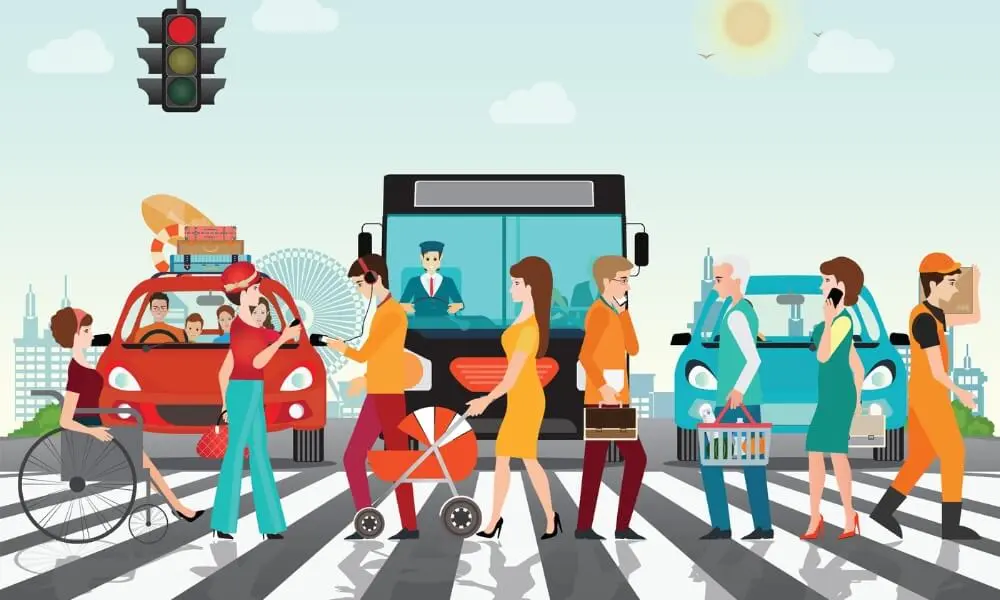As our cities and communities grow, ensuring the safety of pedestrians has become an increasingly important aspect of urban planning and transportation policies. Pedestrians, including those walking, jogging, or using mobility devices, face various hazards in their daily travels. These hazards can result in injuries or even fatalities, from vehicle collisions and poor visibility to inadequate infrastructure and high-speed roads. Creating a safer environment for pedestrians contributes to their well-being. It encourages more people to choose walking as a mode of transportation, leading to healthier communities and reduced traffic congestion.
In this blog, we will explore the different types of hazards that pedestrians may encounter and discuss practical control measures that can be implemented to mitigate these risks. By understanding these hazards and adopting effective strategies, we can work together to make our streets safer and more accessible for everyone. So, let’s dive in and learn about the challenges pedestrians face and the solutions that can help protect them.
Prevention Of Pedestrian Hazards Importance
Preventing pedestrian hazards and accidents is crucial for several reasons, including individuals’ well-being, sustainable communities’ development, and reduced healthcare costs. Pedestrian safety is a global concern, and accident statistics from around the world highlight the importance of addressing this issue.
- Saving lives and preventing injuries: According to the World Health Organization (WHO), around 1.35 million people die yearly in road traffic accidents, with pedestrians accounting for 22% of these deaths. In addition to fatalities, millions of people suffer from non-fatal injuries, resulting in long-term disabilities. Preventing pedestrian hazards and accidents can save lives and reduce the number of injuries.
- Vulnerable road users: Children, the elderly, and people with disabilities are particularly vulnerable to pedestrian accidents. Ensuring safe and accessible environments for these groups is essential for promoting equity and inclusion in our communities.
- Economic impact: The cost of road traffic accidents, including medical expenses, lost productivity, and property damage, is significant. The WHO estimates these accidents cost countries approximately 3% of their gross national product. By preventing pedestrian hazards and accidents, we can reduce the economic burden on individuals, families, and society.
- Encouraging sustainable transportation: Walking is an environmentally friendly and healthy mode of transportation. Creating safe pedestrian environments can encourage more people to walk, reducing traffic congestion, air pollution, and greenhouse gas emissions.
- Promoting public health: Regular walking has numerous health benefits, such as reducing the risk of heart disease, stroke, obesity, and type 2 diabetes. Making our streets safer for pedestrians can promote physical activity and improve public health.
- Enhancing quality of life: Safe and accessible pedestrian environments contribute to the livability of communities, promoting social interaction and creating vibrant public spaces. This can enhance residents’ overall quality of life and attract businesses, tourists, and new residents.
Preventing pedestrian hazards and accidents is a shared responsibility that requires the collaboration of various stakeholders, including government agencies, urban planners, transportation authorities, and the public. Understanding the importance of pedestrian safety and working together to implement effective strategies can create safer and more sustainable communities worldwide.
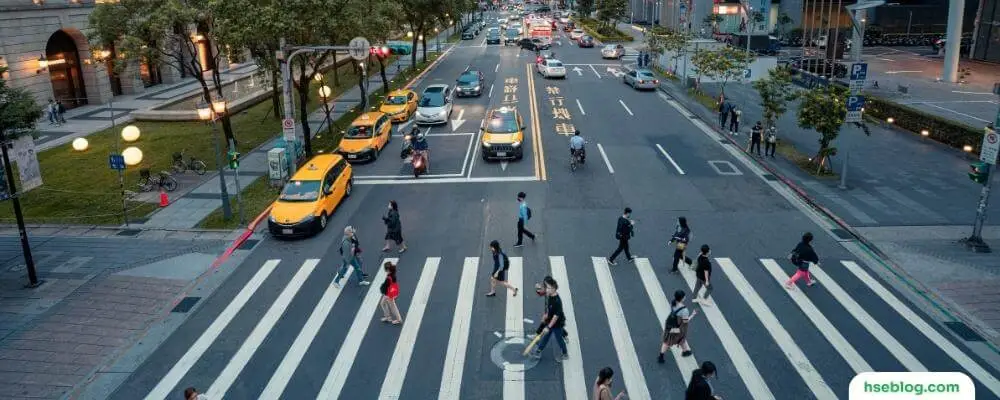
Hazards To Pedestrians & Control Measures
Pedestrians face various hazards while walking or crossing streets. These hazards can lead to injuries or even fatalities. By identifying these hazards and implementing control measures, pedestrian safety can be significantly improved.
Pedestrians may face several types of hazards while walking on or near roadways. Here are some of the most common hazards and potential control measures to reduce their risks:
1. Vehicle Collisions
Vehicle collisions pose a significant threat to pedestrians as they can result in severe injuries or fatalities. Pedestrians are vulnerable road users since they lack the protection offered by a vehicle’s structure, and collisions often occur at high speeds. The risk of being struck by motor vehicles, bicycles, or other types of transportation can arise from various factors:
- Driver behaviour: Aggressive, reckless, or inattentive driving can lead to collisions with pedestrians. Drivers who exceed speed limits, run red lights or stop signs, or fail to yield to pedestrians in crosswalks pose a considerable risk.
- Pedestrian behaviour: Pedestrians may also contribute to collisions by not following traffic signals, jaywalking, or walking on roadways without sidewalks. Distractions like using mobile devices while walking can also lead to hazardous situations.
- Road design and infrastructure: Inadequate or poorly designed pedestrian infrastructure can increase the risk of vehicle collisions. This includes crosswalks that are not clearly marked or visible, missing or malfunctioning pedestrian signals, or roads that lack sidewalks, forcing pedestrians to walk on the roadway.
- Blind spots: Vehicles, particularly larger ones like trucks or buses, may have blind spots where drivers cannot see pedestrians. This can lead to collisions, especially when vehicles make turns or reverse.
- Low visibility conditions: Poor weather, nighttime, or poorly lit areas can reduce visibility for drivers and pedestrians, increasing the risk of collisions.
A combination of traffic calming measures, improved infrastructure, driver and pedestrian education, and enforcement of traffic laws can be implemented to mitigate the risk of vehicle collisions with pedestrians. These strategies work together to create a safer pedestrian environment and reduce the likelihood of collisions with vehicles.
2. Poor Visibility
Poor visibility is a major hazard for pedestrians, increasing the risk of collisions with vehicles. When drivers have difficulty seeing pedestrians due to bad weather, nighttime conditions, or inadequate street lighting, reaction times can be reduced, and the chances of accidents occurring are higher. Here are some factors that contribute to poor visibility and ways to address them:
- Bad weather: Rain, fog, snow, or other adverse weather conditions can reduce visibility, making it harder for drivers to see pedestrians. In such cases, pedestrians should wear reflective or brightly coloured clothing and use umbrellas or raincoats with reflective strips to increase visibility. Drivers should exercise caution, reduce speed, and use appropriate lighting (e.g., fog or low beams) to improve visibility.
- Nighttime: During the nighttime, reduced lighting conditions can make it difficult for drivers to see pedestrians, especially if they wear dark clothing. Pedestrians can enhance their visibility by wearing reflective clothing, carrying flashlights, or using wearable lights. Drivers should be more attentive during nighttime and use their headlights correctly to illuminate the road ahead.
- Inadequate street lighting: Poorly lit streets can create dangerous situations for pedestrians, as drivers may struggle to see them. Communities can address this issue by ensuring that streets are adequately illuminated, particularly in areas with high pedestrian activity. Upgrading to energy-efficient LED streetlights or adding more streetlights can significantly improve visibility.
- Obstructions: Trees, bushes, parked cars, or other obstacles can block drivers’ line of sight and make it difficult to spot pedestrians, especially in low-light conditions. Regular maintenance, such as trimming vegetation and enforcing parking restrictions near crosswalks and intersections, can help enhance visibility.
Addressing these factors and improving visibility can reduce the risk of collisions between pedestrians and vehicles, making roads safer for everyone. Pedestrians and drivers should also be educated about the importance of visibility and the precautions they can take to enhance safety in low-visibility conditions.
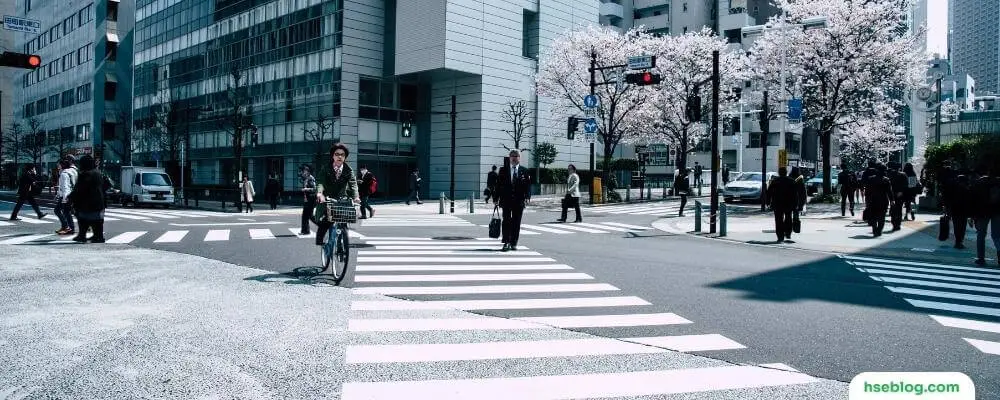
3. Distractions
Distractions can significantly increase the risk of accidents involving pedestrians and drivers. When attention is diverted from the road or walking environment, reaction times are reduced, and the ability to respond to potential hazards is compromised. Here are some common distractions and ways to minimize their impact:
Mobile devices: Smartphones and other electronic devices are a significant source of distraction. Texting, browsing social media, or engaging in phone calls can divert attention from the road or walking path.
| For Drivers | Implement hands-free options, such as Bluetooth or voice-activated systems, and avoid using devices while driving. In many jurisdictions, using a handheld device while driving is illegal and can result in fines or penalties. |
| For Pedestrians | Limit devices while walking, especially when crossing streets or navigating busy areas. If necessary, stop walking before using a device to maintain focus on your surroundings. |
Conversations: Conversing with passengers, other pedestrians, or on the phone can distract from driving or walking safely.
| For Drivers | Keep conversations to a minimum, and avoid emotional or heated discussions that can lead to increased distraction or aggressive driving. |
| For Pedestrians | Be mindful of your surroundings while conversing, and pay attention to traffic signals, vehicles, and other pedestrians. |
Eating, drinking, or grooming: These activities can take a driver’s hands off the wheel or divert a pedestrian’s attention from their surroundings.
| For Drivers | Avoid eating, drinking, or grooming while driving. Pull over to a safe location to engage in these activities if necessary. |
| For Pedestrians | Minimize activities that require the use of your hands or that can obstruct your vision while walking. |
External distractions: Billboards, roadside events, or other activities can draw attention away from the road or walking path.
| For Drivers | Stay focused on the road and avoid getting distracted by external events. Keep your eyes on the road and hands on the wheel. |
| For Pedestrians | Be aware of your surroundings and focus on your walking path and any potential hazards. |
Minimizing distractions and promoting attentive driving and walking can reduce the risk of accidents involving pedestrians. Public awareness campaigns, education, and enforcement of laws related to distracted driving and walking can further encourage responsible behaviour and enhance safety for all road users.
4. Slip And Trip Hazards
Slip and trip hazards pose a significant risk to pedestrian safety. They can lead to accidents ranging from minor scrapes and bruises to severe fractures and head injuries. These hazards are often a result of various factors, which can be classified into two main categories: environmental and man-made.
- Environmental factors: These include natural occurrences, such as wet pavement due to rainfall, snow, or ice buildup during winter months. Also, loose gravel, sand, or mud can create slippery surfaces, particularly in poor drainage or construction zones.
- Man-made factors: These factors involve human intervention, such as poorly maintained sidewalks or walkways with cracks, potholes, or uneven surfaces. Inadequate lighting can also contribute to slip and trip hazards, making it difficult for pedestrians to see potential obstacles. Debris, such as litter or fallen leaves, can further exacerbate the problem by creating additional obstacles and hiding existing ones.
Control measures to reduce slip and trip hazards:
- Regular maintenance: Ensuring that sidewalks and walkways are well-maintained, with timely repairs of cracks, potholes, and uneven surfaces, can significantly reduce the risk of accidents.
- Adequate lighting: Providing sufficient lighting in pedestrian areas, particularly during nighttime and in poorly lit areas, can improve visibility and help pedestrians avoid potential hazards.
- Weather-related precautions: Implementing measures such as sanding, salting, or snow removal during inclement weather can help minimize the risk of slips and trips on icy or wet surfaces.
- Clear signage and warnings: Displaying clear signs and warnings in areas with known hazards, such as construction zones, can alert pedestrians to potential risks and encourage them to take extra caution.
- Public awareness campaigns: Educating the public about the importance of pedestrian safety and the risks associated with slip and trip hazards can promote responsible behaviour, such as using designated walkways and reporting dangerous conditions.
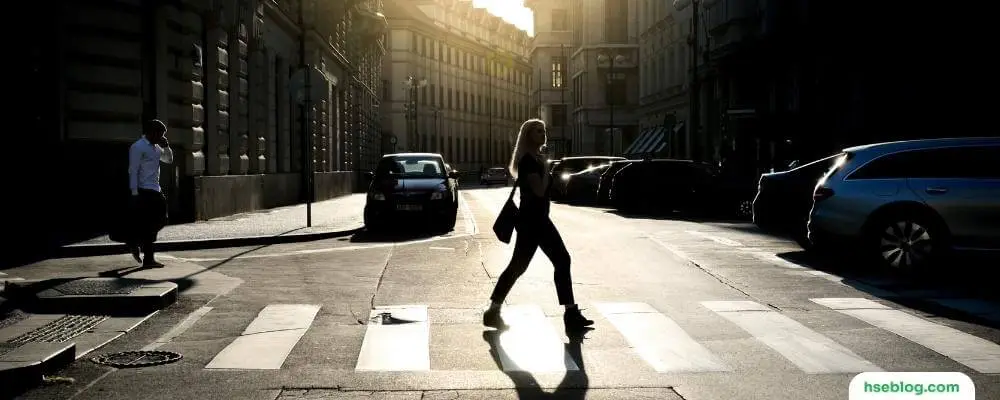
5. Inadequate Infrastructure
Pedestrian safety can be significantly compromised in poorly designed or insufficient infrastructure areas. Inadequate pedestrian provisions, such as narrow or nonexistent sidewalks, poorly designed crosswalks, and missing pedestrian signals, increase the likelihood of accidents and injuries. These conditions expose pedestrians to various hazards, including:
- Forced to walk on roads: When sidewalks are too narrow, nonexistent, or obstructed, pedestrians may be forced to walk on roads, increasing the risk of collisions with vehicles. This is particularly dangerous in areas with high traffic volume or high-speed vehicles.
- Insufficient separation from traffic: Inadequate sidewalks may not provide enough separation between pedestrians and vehicular traffic. This increases the likelihood of pedestrians being struck by vehicles, especially in sudden swerving or vehicle accidents.
- Poorly designed crosswalks: Crosswalks that are not clearly marked, located in low-visibility areas, or lack necessary safety features, such as pedestrian refuge islands, can increase the risk of accidents between pedestrians and vehicles.
- Missing pedestrian signals: In the absence of pedestrian signals at intersections, pedestrians may have difficulty determining when it is safe to cross the road, leading to potential conflicts with vehicular traffic.
Control measures to address inadequate infrastructure:
- Infrastructure improvements: Investing in infrastructure upgrades, such as widening existing sidewalks, constructing new sidewalks where needed, and ensuring that crosswalks are well-designed and clearly marked, can significantly enhance pedestrian safety.
- Pedestrian-friendly design: Adopting pedestrian-friendly urban design principles, such as traffic calming measures, pedestrian refuge islands, and curb extensions, can help create safer pedestrian environments.
- Improved pedestrian signals: Installing pedestrian signals at intersections and ensuring they are well-maintained and functioning correctly can help facilitate safe crossing for pedestrians.
- Regular assessments and maintenance: Regular assessments of pedestrian infrastructure and promptly addressing any identified issues can help maintain a safe pedestrian environment.
- Public awareness campaigns: Educating the public about pedestrian safety and the importance of proper infrastructure can encourage responsible behaviour and increase support for infrastructure improvements.
6. High-speed Roads
The risk of severe injuries or fatalities for pedestrians increases significantly on high-speed roads or in situations where vehicles travel at excessive speeds. High-speed collisions are more likely to result in life-threatening injuries or fatalities due to the greater force of impact. Additionally, drivers have less time to react to unexpected pedestrian movements, and pedestrians have less time to avoid oncoming vehicles. The following factors contribute to the increased risks associated with high-speed roads:
- Reduced reaction time: Higher speeds decrease the time available for drivers and pedestrians to react to potential hazards, making it difficult to avoid collisions.
- Increased stopping distance: Vehicles traveling at higher speeds require longer distances to come to a complete stop, making it more challenging to avoid striking pedestrians.
- Greater impact force: In the event of a collision, the force of impact is significantly greater at higher speeds, increasing the likelihood of severe injuries or fatalities.
Control measures to mitigate risks on high-speed roads:
- Speed reduction measures: Implementing speed reduction measures, such as lowering speed limits, installing speed cameras, or using speed humps, can help discourage speeding and create a safer pedestrian environment.
- Pedestrian overpasses or underpasses: Constructing pedestrian overpasses or underpasses can provide safe crossing points for pedestrians, allowing them to avoid high-speed traffic altogether.
- Traffic calming measures: Implementing traffic calming measures, such as narrowing lanes, installing chicanes or roundabouts, and creating visual cues to encourage slower driving, can help reduce vehicle speeds and enhance pedestrian safety.
- Enhanced crosswalks and pedestrian signals: Installing highly visible crosswalks with pedestrian signals, countdown timers, and adequate crossing time can improve pedestrian safety at intersections and other crossing points.
- Buffer zones and barriers: Creating buffer zones between high-speed roads and pedestrian areas, such as green spaces, fences, or guardrails, can provide a physical separation that reduces the risk of pedestrian-vehicle collisions.
- Education and enforcement: Raising public awareness about the dangers of speeding and enforcing traffic laws can encourage drivers to obey speed limits and exercise caution around pedestrians.

7. Construction Sites
Construction activities often pose hazards to pedestrians in the surrounding area. These hazards can lead to accidents and injuries, particularly when appropriate safety measures are not in place. Common hazards associated with construction sites include:
- Falling objects: Construction work may involve the movement or handling of heavy materials, such as bricks, steel beams, or tools, which can accidentally fall and strike pedestrians below, potentially causing severe injuries.
- Equipment movement: Construction vehicles and equipment, such as cranes, excavators, and trucks, may move in and around the site. Pedestrians nearby may risk being struck by these vehicles, especially if the operators have limited visibility or if pedestrians unexpectedly enter the work zone.
- Blocked pathways: Construction activities may temporarily block sidewalks, pathways, or crosswalks, forcing pedestrians to use alternative routes, which may not be as safe or well-maintained.
- Noise and dust: Construction sites often generate excessive noise and dust, which can be distracting and make it difficult for pedestrians to notice potential hazards or communicate with each other effectively.
- Uneven or unstable surfaces: Construction work can create uneven or unstable surfaces on sidewalks and pathways, increasing the risk of slip and trip accidents.
Control measures to minimize hazards near construction sites:
- Clear signage and barriers: Installing clear signage and barriers around the construction site can alert pedestrians to potential hazards and restrict their access to dangerous areas.
- Designated walkways: Providing safe, well-marked, and well-maintained temporary walkways around the construction site can help ensure pedestrians have a clear path to follow.
- Traffic management plans: Implementing traffic management plans for pedestrian safety, such as coordinating equipment movement and scheduling deliveries during less busy hours, can help minimize conflicts between pedestrians and construction vehicles.
- Covered walkways and debris nets: Installing covered walkways and debris nets can protect pedestrians from falling objects and reduce the risk of injury.
- Regular communication and coordination: Engaging in regular communication and coordination with local authorities, residents, and businesses can help address concerns, identify potential hazards, and ensure that appropriate safety measures are in place.
- Training and supervision: Ensuring that construction workers are properly trained in safety procedures and are supervised by competent personnel can help minimize the risk of accidents and injuries near the construction site.
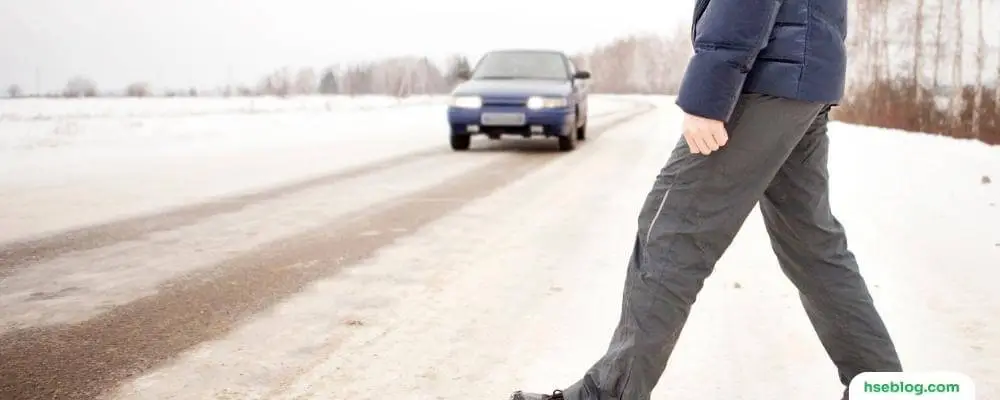
What Can Pedestrians Do To Prevent These Hazards?
Pedestrians can take several steps to help ensure their safety while walking, jogging, or using mobility devices. Here are some practical tips for pedestrians to minimize their risk of accidents and injuries:
- Stay visible: Ensure drivers can see you, especially in low-light conditions or inclement weather. Wear brightly coloured or reflective clothing, and use reflective accessories or lights when walking during nighttime.
- Use sidewalks and designated pathways: Whenever possible, walk on sidewalks or designated pedestrian paths. If there are no sidewalks or paths, walk facing traffic to have a clear view of approaching vehicles.
- Obey traffic signals and signs: Always follow traffic signals, signs, and pedestrian crossing signals. Don’t assume drivers will stop or yield to you, even if you have the right of way.
- Cross streets at marked crosswalks: Use marked crosswalks or intersections when crossing streets, as these locations are generally more visible to drivers. Never assume that a driver sees you, and try to make eye contact with approaching drivers before crossing.
- Stay alert and attentive: Remain aware of your surroundings, and avoid distractions such as using mobile devices, and headphones or engaging in activities that can divert your attention from the road.
- Watch for vehicles backing up: Be cautious around driveways, parking lots, and other areas where vehicles may be backing up. Drivers may not always see you or expect you to be there.
- Be cautious at intersections: Approach intersections cautiously, as drivers may not always yield to pedestrians or turn without signalling. Always look both ways before crossing the street, and be prepared for unexpected vehicle movements.
- Use extra caution in poor weather conditions: When walking in rain, snow, or fog, take extra care to ensure you are visible and can see and hear your surroundings. Adjust your walking pace according to the weather conditions.
- Wear appropriate footwear: Choose good traction to minimize the risk of slipping on wet, icy, or uneven surfaces.
- Be prepared for vehicles not following traffic rules: Some drivers may not follow traffic rules despite traffic regulations. Be prepared for such situations and always remain cautious.
By following these safety tips and practising good pedestrian habits, individuals can reduce their risk of accidents and injuries while navigating the streets. Always vigilant and proactive in maintaining personal safety, regardless of the environment or conditions, is essential for all pedestrians.
Conclusion
As we have seen throughout this blog, there are numerous hazards that pedestrians can encounter in their daily lives. These dangers can significantly impact pedestrian safety, from vehicle collisions and distractions to slip and trip hazards, high-speed roads, and construction sites. However, by implementing targeted control measures, we can greatly reduce the risks and create a safer environment for all road users.
Efforts to improve pedestrian safety should involve a collaborative approach, including local authorities, urban planners, transportation agencies, construction companies, and the community. By prioritizing pedestrian-friendly infrastructure, enforcing traffic regulations, promoting public awareness, and adopting best practices, we can make our streets safer and more accessible.
Ultimately, enhancing pedestrian safety benefits those who walk, jog, or use mobility devices and contributes to healthier, more sustainable, and livable communities. As we work together to address the hazards pedestrians face, we pave the way for a safer and more enjoyable experience for all.

